What is Headless CMS? How to Use it For One Site or Multisite?

What’s Inside
- Comparison Between Headless vs Traditional CMS
- Advantages of a Headless CMS Explained
- What is Decoupled CMS?
- How to Choose the Best Headless CMS?
Learning Point!
- How to Migrate to Headless CMS in 6 Steps? - Stepwise Process Explained
- Headless Architecture and Design
- What is Headless CMS's Content Modeling and Management?
- How Smooth is Headless CMS Integration?
- Headless CMS Frameworks
- What is Headless CMS Multisite & One Site Management?
- How Do Headless CMS and SEO Work Together?
Bonus!
- Use Cases for Headless CMS
- How to Get Started with Headless CMS?
- What is Headless Content Management System? - Future Perspective
- What Edge Does Experro Have Over Other Competitors?
- Looking for a super-fast website or enterprise headless CMS? Experro is your go-to solution!
- What is Headless CMS - A Wrap Up!
Key Takeaways
- This guide will help you to understand what is Headless CMS, and also the concepts that revolve around it.
- You can future-proof your current web platform with headless CMS. Embrace the future of content management, ensuring adaptability and optimal performance.
- It offers major benefits to both the parties – developers and end-customers.
- By the end of this blog, you will be convinced to start or migrate your current platform to headless CMS. There are about six steps in which you can migrate your current web platform to the headless CMS.
Have you ever wondered how websites and apps effortlessly display mind-blowing content, making you go, "Wow, how did they do that?" Well, prepare to have your digital world turned upside down as we dive into the captivating realm of what is a headless CMS!
As the name suggests, it's not some wild creature with no head running amok in the digital universe, I promise! Instead, it's a genius content management system that has undergone a jaw-dropping transformation.
Analogy to understand - It's like watching Spider-Man effortlessly slinging his web across the city, but instead of buildings, it is content popping up all over the digital landscape!
We'll explore how this headless wonderland provides a secret backstage for creators, also arms them with powerful APIs to shoot all the content straight into various channels and digital platforms.
As per a survey by Market Research, the market value of the headless CMS is expected to grow at a CAGR of 20.44%:
- USD 585 million in 2022
- USD 1,787 million by 2028.
Comparison Between Headless vs Traditional CMS
Traditional CMS solutions provide content management and frontend delivery in a single platform, making them simpler but less flexible and scalable. Whereas a headless CMS offers more flexibility and scalability but requires more technical expertise to set up and manage.
For in-depth headless CMS comparison with traditional CMS, head here - Traditional vs Headless CMS.
Advantages of a Headless CMS Explained
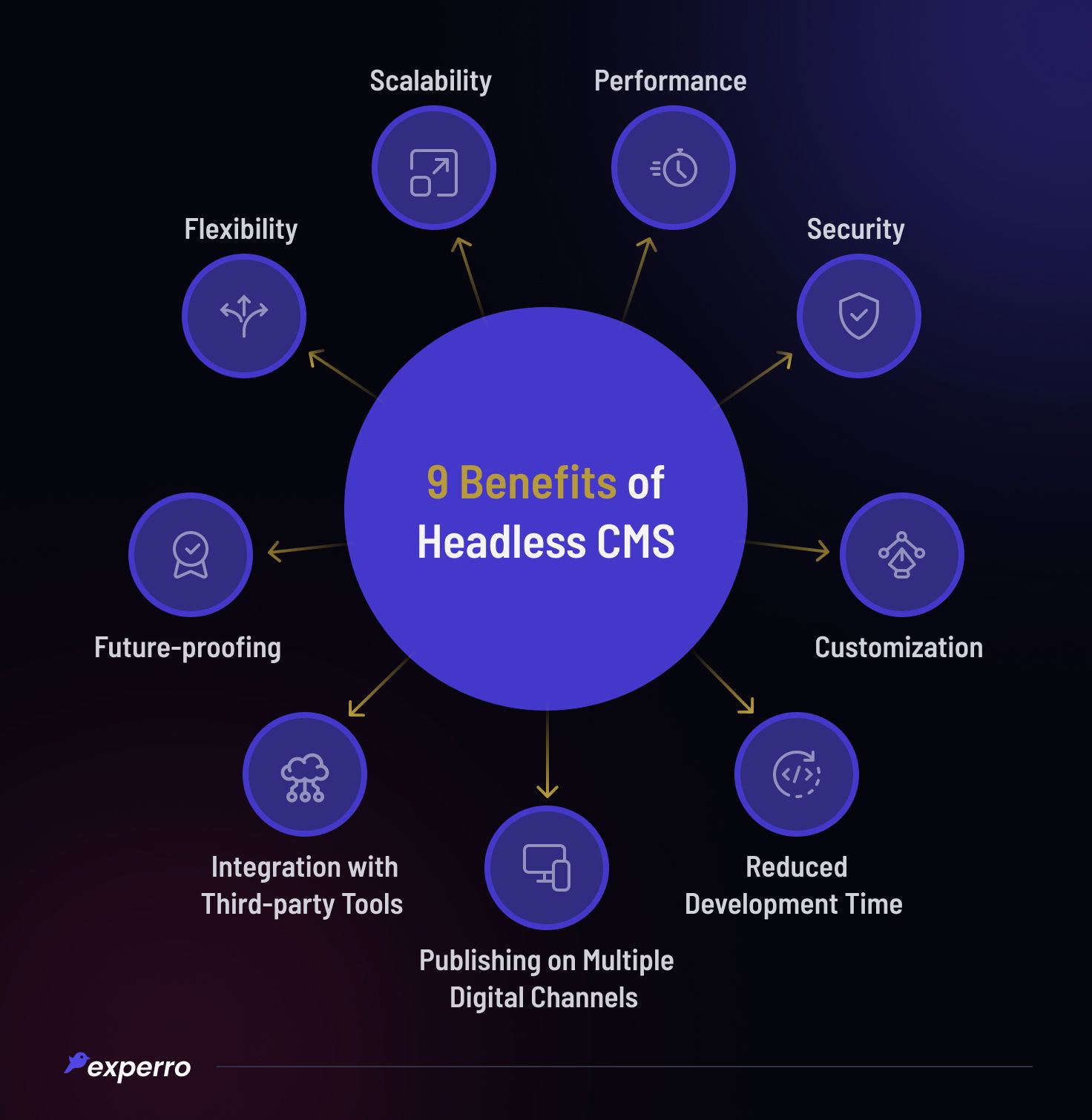
Below-mentioned are some of the major advantages of a headless CMS.
To know the aspects and benefits in detail, you can also head to our blog on headless CMS benefits.
1. Flexibility
The serverless architecture of a headless content management system allows for greater flexibility in creating, managing, and delivering content. It provides organizations with enhanced control over the user experience.
2. Scalability
With a headless CMS, organizations can easily scale their content management processes to meet the demands of their growing business, without having to worry about the limitations of a traditional monolithic CMS.
3. Performance
By eliminating the need for a traditional front-end, headless CMS can significantly improve the speed and performance of websites and other digital properties, providing a better user experience and helping to drive conversions.
4. Security
Headless CMS can offer improved security compared to traditional monolithic CMS, as there are fewer potential attack surfaces for hackers to exploit.
5. Customization
Headless CMS provides organizations with more control over the look and feel of their digital properties, allowing them to fully customize their user experience to meet the needs of their customers and stakeholders.
6. Integration with Third-party Tools
With a headless CMS, organizations can easily integrate with third-party tools and platforms, such as analytics and marketing automation solutions, to provide a more complete and integrated user experience.
7. Futureproofing
By eliminating the need for a traditional front-end, headless CMS can help organizations to future-proof their digital content management processes, allowing them to quickly and easily adapt to new and emerging technologies.
8. Reduced Development Time
Organizations can reduce the time and resources needed to develop and launch new structured content. This allows them to focus on delivering value to their customers and stakeholders.
9. Improve Core Web Vitals Efficiency-
Organizations can boost core web vitals with a headless CMS by delivering faster load times, improved interactivity, and smoother visual stability. This ensures optimized performance, enhancing user experiences and driving better engagement across all digital touchpoints.
10. Publishing on Multiple Digital Channels
It allows organizations to easily publish and manage content across multiple digital channels and platforms, including websites, mobile apps, voice assistants, and more, providing a more consistent and integrated user experience.
What is Decoupled CMS?
It refers to a content management system that provides a back-end platform for managing and storing content, separating it from the front-end content presentation layer that displays the content to end-users.
The front-end presentation layer can be built using any technology stack, including websites, mobile apps, voice assistants, and other digital touchpoints.
After knowing what is a headless CMS, you might confuse it with decoupled. Read in-depth about What is decoupled CMS to clarify the confusion.
How to Choose the Best Headless CMS?
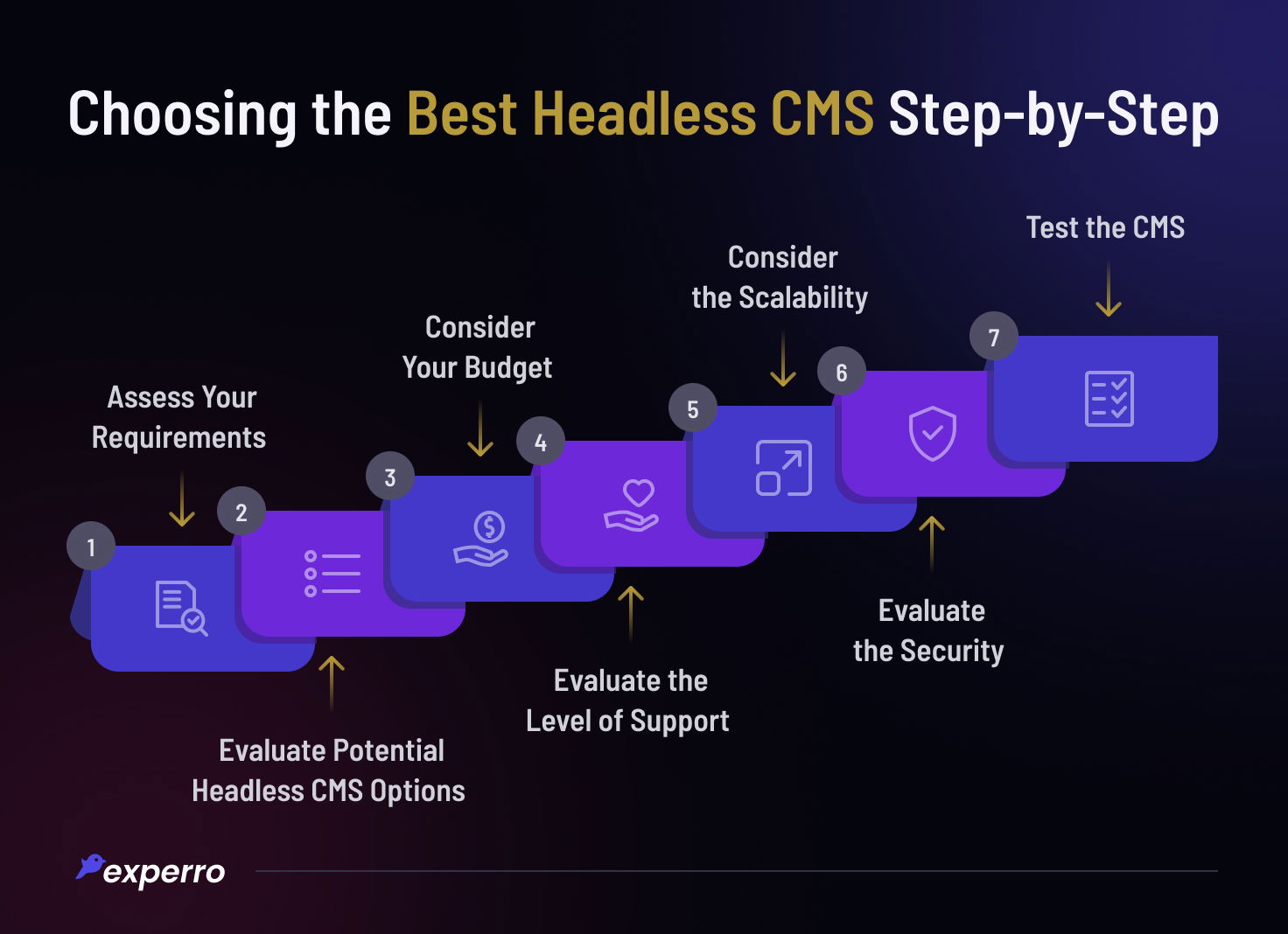
We know that there is a plethora of headless CMS solutions available in the market. Making the right choice will fetch you far more results than the wrong one.
You may also choose a hybrid CMS to leverage the combined features of a traditional and a headless CMS together.
1. Assess Your Requirements
Identify your specific requirements for your headless CMS, including performance, security, scalability, ease of use, and the ability to integrate with third-party tools.
Consider the unique challenges and opportunities that your organization faces.
2. Evaluate Potential Headless CMS Options
Research and evaluate the different headless CMS options available, taking into account your specific requirements and goals.
Consider factors such as cost, ease of use, scalability, and security.
3. Consider Your Budget
Determine how much you are willing and able to spend on a headless CMS, taking into account your specific requirements and goals.
Consider both the upfront cost of the CMS itself and the ongoing costs of deployment, support, and maintenance.
4. Evaluate the Level of Support
Consider each headless CMS option's level of support, including documentation, community support, and professional services.
Determine whether you have the resources and expertise to manage the CMS on your own or whether you will need additional support.
5. Consider the Scalability
Evaluate the scalability of each headless CMS option, taking into account your current and future needs.
Consider factors such as the ability to handle large amounts of data, the ability to scale up or down as needed, and the ease of scaling the solution. Experro is a top-performing enterprise level headless CMS.
6. Evaluate the Security
Consider the security features and capabilities of each headless CMS option, taking into account your specific requirements and goals.
Determine the level of security that each CMS provides and whether it meets your needs.
7. Test the CMS
Before making a final decision, test the headless CMS options you are considering to ensure they meet your requirements and goals.
Consider factors such as performance, ease of use, and integration with third-party tools.
Learning Point!
Read more about this in a dedicated blog here - Why & how should you choose a headless CMS?
By following these steps, organizations can choose the best headless CMS for their specific needs, taking advantage of its many benefits and delivering a better user experience to their customers and stakeholders.
So now, naturally the question popping in your mind is how to transition to a Headless CMS?
How to Migrate to Headless CMS in 6 Steps? - Stepwise Process Explained
We know you are super enticed to migrate your current CMS to a headless one. So, let's quickly dive deep into exploring the procedure to migrate your existing same content to headless content management systems.
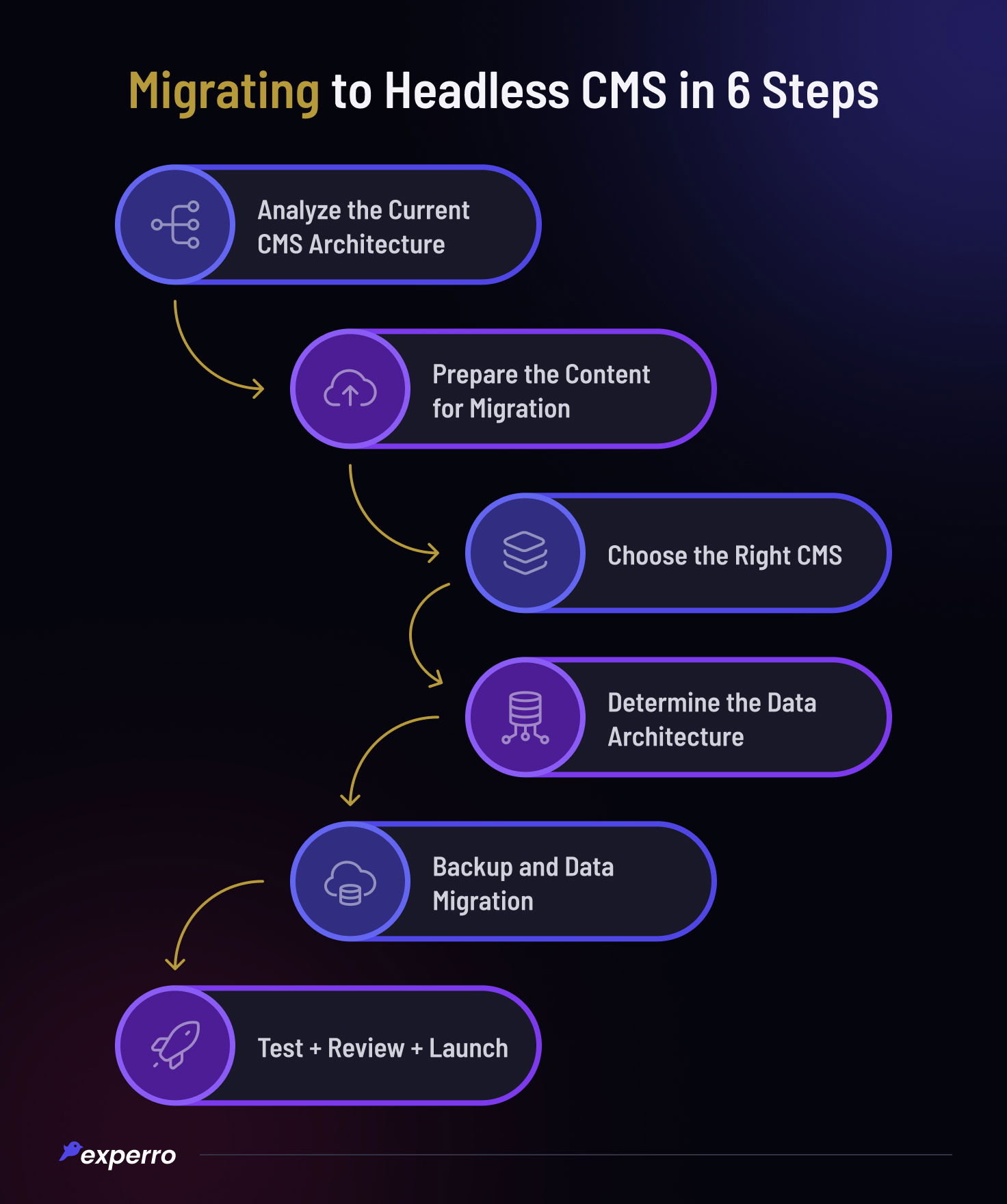
- Analyze the Current CMS Architecture – Your first step would be to analyze the present CMS architecture and find the bugs and lags. These bugs and lags are the main reasons to start headless CMS migration.
- Prepare the Content for Migration – Check out what all content pieces exist on your website. This involves a lot of structuring and organizing of your content.
- Choose the Right CMS – Making the right choice is very integral as you are already regretting your current choice of CMS. Hence, this is the time to switch to a headless CMS.
- Determine the Data Architecture – The data types and relations must be gauged before the migration takes place.
- Backup and Data Migration – For precautionary purposes, take a backup of all your data. Post this, go ahead and mi grate your data to the brand-new headless CMS.
- Test + Review + Launch – Yes, this is the most important step. Test the quality of the data in all ways possible. Give it a fresh pair of eyes, ask the quality analysis team to go through and then launch your website in the new headless CMS.
Learn the in-depth process of migrating to a headless CMS.
Headless Architecture and Design
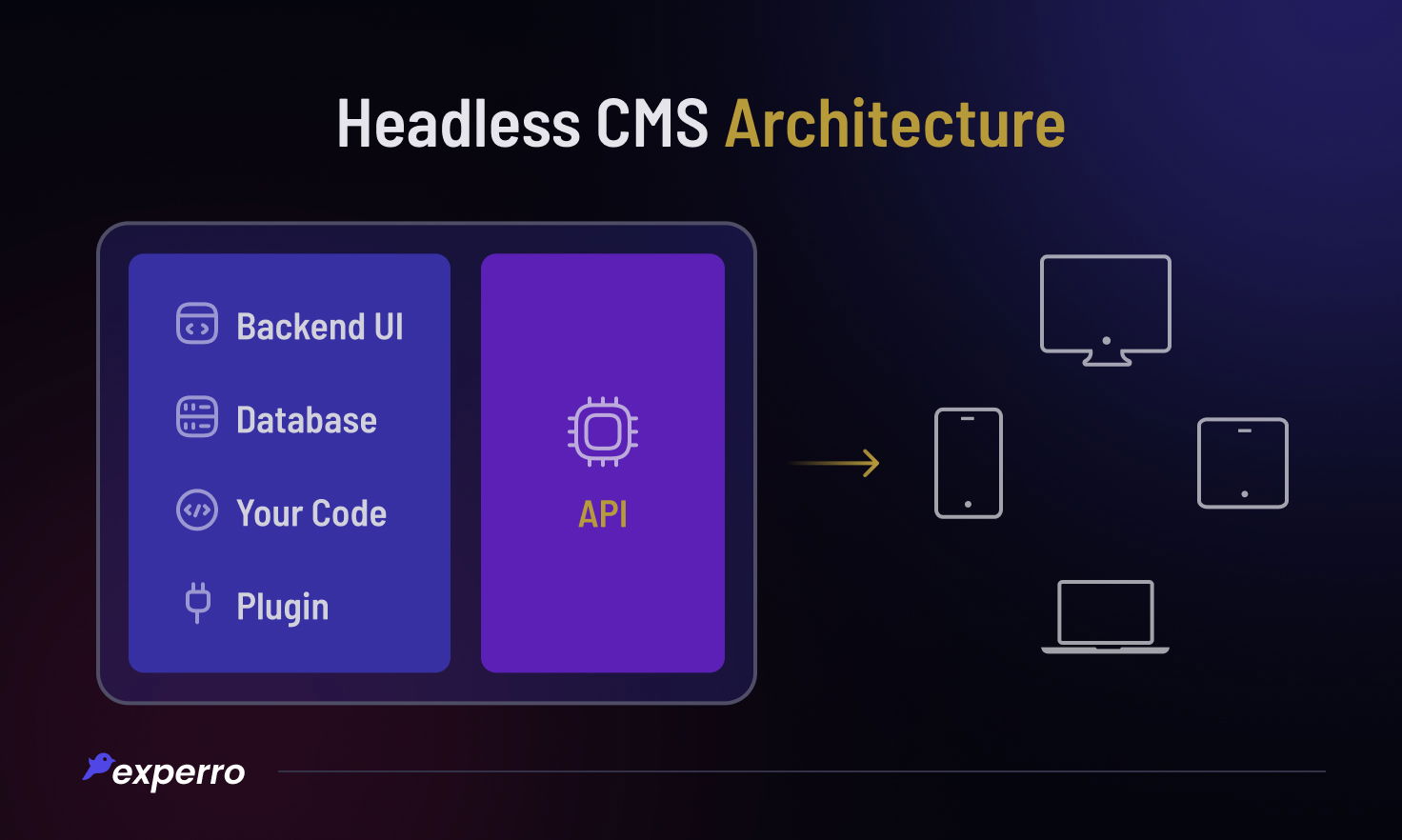
If you want to know what is headless CMS architecture, it portrays the following features:
- Decoupled Architecture: A headless CMS has a backend for content management and a frontend for content delivery, separated by headless APIs. This allows for greater flexibility in choosing frontend technologies and improved performance and scalability.
- Backend and Frontend Separation: The backend and frontend are separate and communicate through APIs, allowing for flexible and efficient delivery of content to multiple platforms.
- API-first Approach: A headless CMS uses APIs as the primary method of delivering content, enabling developers to access and display content in a variety of formats and technologies.
- Content Management and Delivery: The backend manages and stores content, while the frontend displays and delivers content to various channels and devices.
- Aligned with MACH Architecture: Headless CMS aligns perfectly with the MACH architecture (Microservices, API-first, Cloud-native, and Headless), offering unparalleled flexibility, scalability, and innovation for modern digital experiences.
What is Headless CMS's Content Modeling and Management?
As an entrepreneur, you should learn about how content modeling and structuring affects your website. Having some knowledge about this will help you take informed decisions when it comes to your website.
- Defining content types and structures: A headless eCommerce CMS provides a backend for defining and organizing content types, such as pages, articles, products, and more.
- Managing and organizing content: The backend provides tools for managing and organizing content, such as categories, tags, and custom fields.
- Role-based access control and permissions: The backend provides role-based access control and permission management, allowing for fine-grained control over who can access and modify content
- Version control and content history: The backend provides version control and content history, enabling users to revert to previous versions of content and track changes over time.
How Smooth is Headless CMS Integration?
So, what is Headless CMS integration? It is a process that allows content stored in a content management system (CMS) to be retrieved and used on any device or platform.
Below are the ways you can integrate your eCommerce store with headless CMS or with other applications and services:
- Integrating with existing systems and applications
- Integrating with third-party headless CMS APIs and services
- Customizing and extending the Headless CMS backend and frontend.
Headless CMS Frameworks
A headless CMS (Content Management System) framework is a tool that allows developers to create and manage content for their applications without worrying about the frontend or presentation layer.
This architecture is ideal for building headless CMS websites, enabling flexibility and scalability in content delivery across multiple platforms.
Essentially, it separates the content management from the presentation layer, allowing developers to focus on building the frontend while relying on the CMS framework to provide the backend and APIs for content delivery.
Choosing the right one depends on factors like ease of use and specific requirements. With the right framework, developers can build customized applications for seamless content delivery.
What is Headless CMS Multisite & One Site Management?
While witnessing the three-ring gameplay by jokers in a circus, have you ever wondered about the stress and the pressure that they have while multi-tasking?
Well, if you are a website owner, website manager, or a CTO, you might be in the same puddle too!
If you are finding difficulty in managing too many websites altogether or if have you been using multiple CMSs for managing your sites, we have an amazing solution for you!
Well, to your surprise, headless CMS is a great solution to this problem also.
Do you know... you can use headless CMS to manage a single as well as a multisite!
But First, What is Multi-Site Management?
The strategy through which you can manage and control data on multiple websites, mobiles, and web applications while using the same platform is called multi-site management. And this can be managed easily with the headless CMS.
Headless CMS is very suitable for single site management. However, when it comes to managing more than one, headless CMS still is at the top. We can ensure you about the scalability, efficiency, and control if you use Experro headless CMS.
How Do Headless CMS and SEO Work Together?
In truest means, headless CMS and SEO are a match made in heaven. We all are aware that SEO is crucial for a headless content management system because it affects the visibility and discoverability of content across search engines.
This ensures that the content is easily understood by search engines and maximizes its impact across multiple channels and devices.
These solutions provide tools and options, such as metadata, page titles, descriptions, and server-side rendering, to optimize content for SEO.
Ongoing best practices, such as regular updates and optimization, tracking and analyzing performance data, and improving the user experience, are also critical for improving SEO.
By using these tools and practices, developers and content creators can maximize the impact of their content and improve its visibility and discoverability.
Bonus!
Check out the latest headless CMS and commerce statistics to know more about the importance and predictions for the industry.
Use Cases for Headless CMS
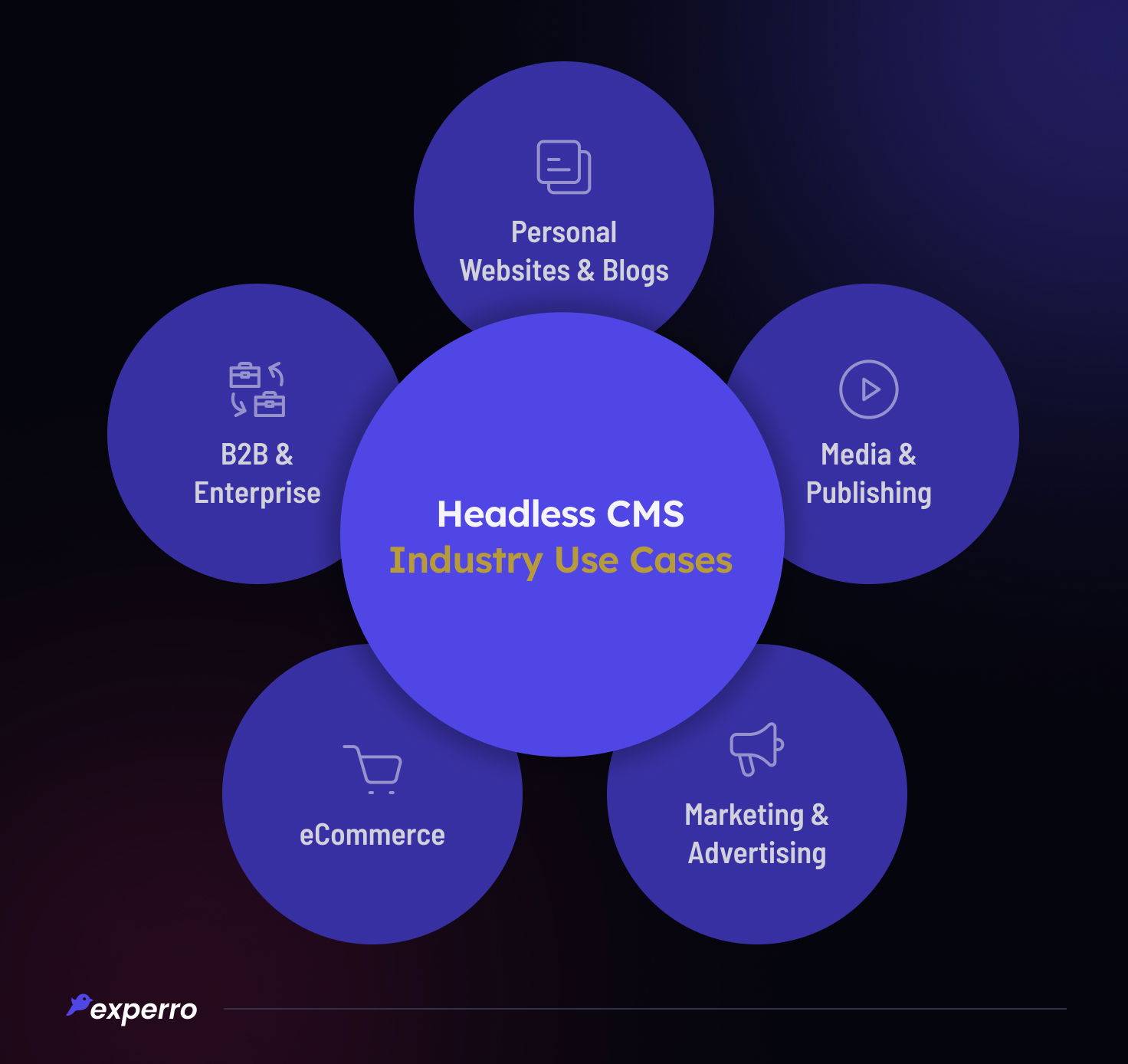
Below are a few of the most common headless CMS use cases for implementation:
- eCommerce: It can be used to power e-commerce sites, providing a seamless user experience, dynamic content, and personalized recommendations.
- Media and Publishing: It can be used in media and publishing, providing an efficient and scalable way to manage and deliver content to a wide range of devices and platforms.
- B2B and Enterprise: It can also be used in B2B and enterprise settings, providing a flexible and customizable way to manage and deliver content to customers, partners, and employees.
- Personal Websites and Blogs: It can be used to power personal websites and blogs, providing a simple and streamlined way to manage and publish content.
- Marketing and Advertising: It can be used in content-first marketing and advertising, providing a flexible and customizable way to manage and deliver dynamic content to customers and prospects.
How to Get Started with Headless CMS?
Now that you have migrated or deployed from scratch your brand new Experro headless CMS, let's check out the procedure of getting started with its functioning.
Choosing the Right Headless CMS
Many headless CMS options are available, so choosing the right one is important based on your specific needs and requirements.
Setting Up a Headless CMS
Setting up a headless CMS typically involves integrating it with your website or web application and setting up the necessary APIs and data models.
Creating and Managing Content
With a headless CMS, content creation and management are typically done through a web-based interface, or via headless APIs.
Deploying and Scaling
After the set up and configured, you'll need to deploy it and scale it as your needs and traffic grow.
What is Headless Content Management System? - Future Perspective
Having thrown light on what is headless CMS and its current position in the industry, here are a couple observations from our end about its future.
Continued Growth and Adoption
As more organizations seek to provide dynamic and personalized user experiences, headless CMS is expected to continue to grow in popularity.
Technological Advancements
As technology continues to evolve and mature, new features and capabilities are likely to become available.
Integration with Other Technologies
CDN integration with headless CMS helps provide even more advanced and personalized user experiences.
Expansion of Use Cases
The use cases for headless CMS may expand to include new industries and applications, further increasing its impact and influence in the world of content management and delivery.
What Edge Does Experro Have Over Other Competitors?

Although the market names many platforms the best in the industry. But we have good reasons to declare Experro the best CMS and DXP in the market.
Experro is an all-inclusive, completely managed Digital Experience Platform that delivers each visitor quick, customized, and unforgettable eCommerce experiences.
1 - What unique features does Experro offer that you won't find in Strapi?
Experro offers easy-to-use content modeling and management capabilities along with advanced content delivery and presentation options. Seamless integration with third-party systems and applications is a cherry on the top that sets it apart from Strapi.
2 - What unique modules does Experro offer that you won't find in Contentful?
Contentful doesn't follow its name trail and is not 'full of features'. While Experro provides modules like a visual editor, drag-and-drop interface, and built-in Digital Asset Management (DAM), Contentful falls short in these areas. Experro's modular content approach in headless CMS ensures flexibility and ease of use, making it simple for non-tech operators to use features like the visual editor for uploading content.
3 - What unique features does Experro offer that you won't find in Sanity?
We are better than Sanity because of the feature set, scalability, wide integration capabilities, and support that we offer with Experro.
4 - What unique functionalities does Experro offer that you won't find in Prismic?
Experro is such a flexible platform that provides content localization and internationalization flexibilities. In addition to this, there are numerous useful tools for A/B testing, content targeting, and personalized recommendations available. On the other hand, Prismic has no such functionalities available.
5 - What unique features does Experro offer that you won't find in Kentico Kontent?
Although Kentico Kontent is based on AI, it still lacks real-time content editing and previewing with so many other important features. Factors that distinguish Experro from Kentico Kontent are the seamless content collaboration and digital experience management capabilities.
6 - What unique features does Experro offer that you won't find in Contentstack?
Experro offers hosting and AI-based search which is very much missing in Contentstack. That's what pushes it above.
What is Headless CMS - A Wrap Up!
In conclusion, a headless CMS is a powerful and flexible content management solution that offers a range of benefits and opportunities for organizations seeking to create and deliver engaging and personalized user experiences.
Whether you are looking to improve performance, increase efficiency, or provide a more seamless and consistent user experience across a wide range of devices and platforms, it can help you achieve your goals.
To learn or discuss more, feel free to consult the experts in our team.
FAQs


Ekta Ganwani
21 June 2024With a sharp knowledge of SEO and SERP, Ekta's research is her strength. She is a meticulous researcher with an eagle eye for finding errors and ensuring on-page content is top-notch. When not working, Ekta can be found binging the latest Netflix series or meditating to find her inner zen.